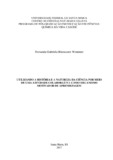| dc.creator | Wommer, Fernanda Gabriela Bitencourt | |
| dc.date.accessioned | 2018-03-26T13:38:12Z | |
| dc.date.available | 2018-03-26T13:38:12Z | |
| dc.date.issued | 2017-03-03 | |
| dc.identifier.uri | http://repositorio.ufsm.br/handle/1/12803 | |
| dc.description.abstract | The present study aims shows that Scientific Literacy involves more than the domain of scientific theories and concepts, it shows that it is necessary to incorporate understanding about the Nature of Science, thus promoting the development of scientific skills in the classroom. The History of Science is an important component when trying to understand the Nature of Science. This study was carried out in a rural elementary school with 12-to-15-year-old students. It was developed through a collaborative activity which aimed at rewriting the classic Micrographia book written by Robert Hooke in 1665. It was tested if this activity improve the possibility to teach aspects about the History and Nature of Science by developing scientific competences. In order to rewrite the book, students were first introduced to the historical context in which Robert Hooke lived, demonstrating cultural and scientific aspects related to that historical period. In the next step, students explored their home and school environments using a microscope made by themselves, built with PET bottles and lenses obtained from CD / DVD players to unravel an invisible world in which they had not previously known. After these steps, students had to draw and describe the structures observed using the microscopes, where they collaboratively rewrote the classic book, creating a replica. The learning evidences were evaluated through a quantitative tool called the Historical Word Association Test (HWAT), which aims to evaluate the general view of students about the historical period and the sociocultural circumstances involved. The students who participated in the didactic activity showed improvement in the identification and retention of ideas associated to the history of the discovery of the microscopic world, comparing to students who did conventional activities. | eng |
| dc.description.sponsorship | Coordenação de Aperfeiçoamento de Pessoal de Nível Superior - CAPES | por |
| dc.language | por | por |
| dc.publisher | Universidade Federal de Santa Maria | por |
| dc.rights | Attribution-NonCommercial-NoDerivatives 4.0 International | * |
| dc.rights.uri | http://creativecommons.org/licenses/by-nc-nd/4.0/ | * |
| dc.subject | Micrographia | por |
| dc.subject | História da ciência | por |
| dc.subject | Aprendizagem colaborativa | por |
| dc.subject | Micrographia | eng |
| dc.subject | History of science | eng |
| dc.subject | Collaborative learning | eng |
| dc.title | Utilizando a história e a natureza da ciência por meio de uma atividade colaborativa como mecanismo motivador de aprendizagem | por |
| dc.title.alternative | Using the history and nature of science through a collaborative activity as a learning and motivation tool | eng |
| dc.type | Dissertação | por |
| dc.description.resumo | O presente estudo busca mostrar que a Alfabetização Científica envolve mais do que o domínio das teorias científicas e conceitos, mostra que é preciso incorporar a compreensão sobre a Natureza da Ciência, assim promovendo o desenvolvimento de competências científicas em sala de aula. A História da Ciência é um componente importante para compreender a Natureza da Ciência. Este estudo realizou-se em uma escola rural de ensino fundamental, com estudantes entre 12 a 15 anos de idade, foi desenvolvido por meio de uma atividade colaborativa visando reescrever o livro clássico Micrographia, escrito por Robert Hooke, em 1665, testamos a hipótese de que com esta atividade é possível ensinar aspectos sobre a História e a Natureza da Ciência desenvolvendo competências científicas. Para reescrever o livro, primeiramente os alunos foram apresentados ao contexto histórico em que viveu Robert Hooke, demonstrando aspectos culturais e científicos relacionados ao período histórico. Na próxima etapa, os alunos exploraram o ambiente escolar e domiciliar utilizando um microscópio feito por eles mesmos, construído com garrafas PET e lentes obtidas em leitores de CD/DVD para desvendar um mundo invisível que até então não conheciam. Após estas etapas, os alunos tiveram que desenhar e descrever as estruturas observadas nos microscópios, de forma colaborativa reescreveram o livro clássico criando uma réplica. As evidências de aprendizagem foram avaliadas por meio de uma ferramenta quantitativa, denominada Teste de Associação de Palavra Histórica (TAPH), que visa avaliar a visão geral de estudantes sobre o período histórico e as circunstâncias socioculturais envolvidas. Os alunos que participaram da atividade didática mostraram melhoria na identificação e retenção de ideias associadas à história da descoberta do mundo microscópico, comparando com estudantes que fizeram atividades convencionais. | por |
| dc.contributor.advisor1 | Loreto, Elgion Lucio da Silva | |
| dc.contributor.advisor1Lattes | http://lattes.cnpq.br/6493669115018157 | por |
| dc.contributor.referee1 | Barbosa, Nilda Berenice de Vargas | |
| dc.contributor.referee1Lattes | http://lattes.cnpq.br/5901511067144019 | por |
| dc.contributor.referee2 | Sartori, Paulo Henrique dos Santos | |
| dc.contributor.referee2Lattes | http://lattes.cnpq.br/9680419106224563 | por |
| dc.creator.Lattes | http://lattes.cnpq.br/1507033634827410 | por |
| dc.publisher.country | Brasil | por |
| dc.publisher.department | Bioquímica | por |
| dc.publisher.initials | UFSM | por |
| dc.publisher.program | Programa de Pós-Graduação em Educação em Ciências: Química da Vida e Saúde | por |
| dc.subject.cnpq | CNPQ::CIENCIAS BIOLOGICAS::BIOQUIMICA | por |
| dc.publisher.unidade | Centro de Ciências Naturais e Exatas | por |



